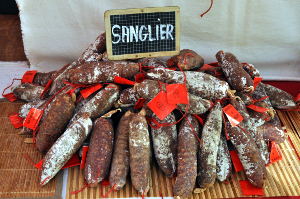Cuisine de Provence
For Book Clubs Wishing to Serve Authentic Dishes
For a novel taking place in Provence, the narrative must be warmed by the dry climate, and must make abundant reference to local cuisine, the result of grazing sheep and goats in the higher elevations and the beef in the coastal Camargue. Added to this, the vineyards for wines and table grapes, the orchards of cherries, apricots, peaches, and almonds, the strawberry and melon fields, the vegetable plots, and the seacoast all contribute to a healthy Mediterranean cuisine. And I must not overlook mentioning boar sausage, lavender honey, the wide variety of olives, olive oil which is used instead of butter, and of course, herbes de provence. Most foods are purchased at outdoor markets. Freshness is de rigeur .I cannot claim that this offering is exhaustive. Here I'm only including foods mentioned in Lisettle's List to tantalize book clubs looking to augment their book discussions with authentic cuisine.
Chapter 8
He asked me to prepare Daube for him on Saturday. His voice was pleading, like the near-whine of a child. I had to ask him what it was.
"A traditional Provençal dish, sort of a beef ragout simmered with red wine. It has orange peel and tomato and carrots and those little round onions. Pick some rosemary for it. Cézanne would have eaten it on a Saturday too."
That made me realize how intensely Pascal lived in the paintings.
There are 17 recipes for Daube on the internet. This one seemed easiest, although it's more authentically Provençal to serve it with rice from the Camargue rather than pasta. http://frenchfood.about.com/od/maindishes/r/daubeprov.htm
Chapter 9
"What's that garlic for?" he asked.
"Daube "
"Wrong time. It's an early winter dish. Wait until November."
I would use tomatoes, onions, and green olives instead of orange rind, anchovies, and white wine instead of red, and I would call it Boeuf Arlésien instead of Daube .
Chapter 10
I bought pain fougasse, a flat olive loaf which he loved, and I asked René to make some palmiers, his favorite pastry. We fed morsels to each other just as we had done in Paris and he called me his perfect lily.
Versions can be found in Spain, Germany, Italy, Portugal, even China. I love them so I had to have Lisette ask René, the boulangère, to make some before André went off to war. See a plethora of them on https://www.google.com/search?q=palmiers+recipe&tbm=isch&tbo=u&source=univ&sa=X&ei=0BdfUq3uJoODqgHBzYCACg&sqi=2&ved=0CFEQsAQ&biw=1009&bih=908
Chapter 13.
Most unexpected, Madame Bonnelly, a stout woman with thick arms whom I didn't know, brought Gratin d'aubergines, eggplant and tomato pie garnished with bread-crumbs.
"Keep up your strength, dear," she said.
Google Gratin d'aubergines images for a wide array, beautifully presented, with recipes.
Chapter 19
Months later Geneviève's belly and teats grew large and her udder firm. One morning I came out to see two baby male goats suckling hungrily. When they were large enough, after three months, I gave them to Louise and Maurice. One by one Louise roasted them, Chevreau Provençale style with garlic and herbs. Toughening myself, I ate two hearty meals at their house. I was becoming reconciled to the ways of the country.
Chapter 19
"Ah, the French cuisine, so delicate and savory." The officer ladled out a bowlful, pulled out a chair and sat at the table facing me. Waiting until it cooled, he put his feet in muddy boots on a chair to the side and drummed his fingers on the table. When he began spooning it into his mouth, I fumed at his sense of entitlement.
"Not bad, madame. What do you call it?"
"Pistou à la Provençale." I exploded my "p's" at him as if they were bullets.
"Pistou à la Provençale," he repeated, gently, mocking me. He lit a cigarette.
"If you refuse to tell me, I will be forced to tell my captain, who has a ravaging hunger for art, and a rough way about him."
Here's a relatively easy recipe for a winter book club meeting. Naturally, it begins with olive oil and includes goat cheese croutons: http://www.foodnetwork.com/recipes/wolfgang-puck/provencal-vegetable-soup-soupe-au-pistou-recipe/index.html
Chapter 20
Kooritzah stopped laying altogether. Knowing I could not bring myself to eat her, Louise told me that I should give her away for food. That hit me hard. Kooritzah had become a friend. Sadly, I did as Louise directed, and pictured Maurice enjoying Louise's Fricassée de poulet Arlésienne with onions, peppers, garlic, and white wine.
Chapter 22.
"'Be a man! Hunt me a boar!' Madame Boriewoman would demand. 'I'm dying to prepare Sanglier Chasseur aux herbes de Provence, hunter style with mushrooms, shallots, and white wine.'"

|
Chapter 27.
We hurried back downhill the distance of five houses and found him calmly spooning minestra, Louise's thick Corsican bean and vegetable soup, into his mouth.
The making of marzipan is featured in chapters 28 and 29.
Chapter 32
At Au Petite Riche, the bistro near the opera, Lisette, Maxime and Héloïse eat "small beef tenderloins topped with an artichoke bottom filled with sauce béarnaise and garnished with a round of butter-fried goose liver."
Chapter 34
The trout arrived browned in butter under a scattering of toasted almond slices, complemented by white asparagus, and potato sticks pont neuf, arranged like a bridge over banks, and garnished with a stuffed tomato and a radish tulip, dramatically composed, an art form framed by the wide gold embossed edge of the white china.


